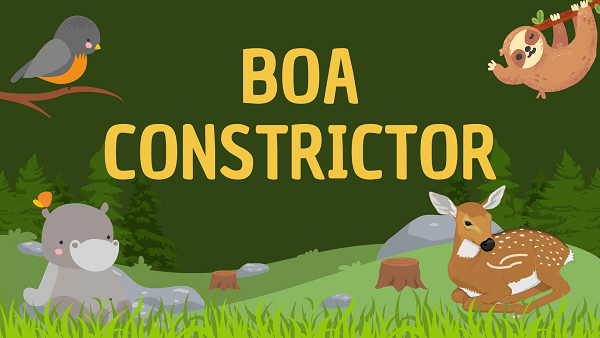Boa Constrictor | Facts, Diet, Habitat & Pictures
Home » Animals » Boa Constrictor | Facts, Diet, Habitat & Pictures
Boa Constrictor Overview
Appearance
The boa constrictor is a large, heavy-bodied snake with a sleek, muscular appearance. Its coloration varies, often featuring earthy tones like brown or green, with distinctive saddle-shaped markings along its back. Boas have a distinctive triangular head and heat-sensing pits along their jaws.
Their bodies are covered in smooth scales, which give them a glossy appearance. Boa constrictors are known for their impressive size, which can range from several feet to over ten feet in length, depending on the species.
Origins And Evolution
Boa constrictors have ancient origins dating back millions of years to the Paleocene epoch, around 60 million years ago. Fossil evidence reveals their presence on both the continents of North and South America. Over time, these serpents evolved into a diverse group of species, adapting to a wide range of habitats.
Boas belongs to the Boidae family, which includes primitive and well-preserved traits such as live birth, or viviparity. Their evolutionary journey showcases their success in becoming efficient ambush predators. Boas demonstrate resilience and adaptability in the ever-changing ecosystems they inhabit, from dense rainforests to arid deserts.
Behavior and Lifestyle
Boa constrictors are primarily solitary and nocturnal snakes, preferring to hunt and move under the cover of darkness. They are ambush predators, relying on stealth and their strong bodies to capture prey. Boas are constrictors, coiling their bodies around their prey and squeezing it until it suffocates.
After a meal, they may go for an extended period without eating again. These snakes are often found near water sources and are skilled swimmers, enabling them to access different hunting grounds and escape predators.
Scientific Classification
- Kingdom: Animalia
- Phylum: Chordata
- Class: Reptilia
- Order: Squamata
- Suborder: Serpentes
- Family: Boidae
- Genus: Boa
- Species: Constrictor
Locations
- North America
- Central America
- South America
- Caribbean islands
- Introduced populations in Florida, USA
Fast Facts
- Name: Boa Constrictor
- Scientific Name: Boa constrictor
- Habitat: Varied (rainforests, deserts, savannas, tropical forests)
- Diet: Carnivorous (small mammals, birds, reptiles)
- Physical Features:
- Heavy-bodied with smooth scales
- Triangular head with heat-sensing pits
- Length can vary from a few feet to over 10 feet
- Distinctive saddle-shaped markings
- Nocturnal: Mostly nocturnal
- Solitary: Typically solitary
- Unique Order: Squamata order
- Lifespan: 20-30 years (in captivity)
- Conservation Status: Varied (some populations stable, others declining)
- Fun Facts: Boa constrictors are non-venomous and kill their prey by constriction.
Physical Characteristics
- Color: Varied (brown, green, or reddish-brown with saddle-shaped markings)
- Skin Type: Smooth scales
- Top Speed: Approximately 5-10 mph (8-16 km/h)
- Lifespan: 20-30 years (in captivity)
- Weight: Varies by age and species, typically 10-60 lbs (4.5-27 kg)
- Length: Varies by age and species, typically 3-13 feet (0.9-4 meters)
- Age of Sexual Maturity: 2-4 years (species-dependent)
- Age of Weaning: Not applicable (boa constrictors do not nurse their young)
Boa Constrictor FAQs
How do boa constrictors kill their prey?
Boa constrictors use constriction to kill their prey. They coil their bodies around their prey, squeezing it until it suffocates.
What do boa constrictors eat?
Boa constrictors are carnivorous and primarily feed on small mammals, birds, and reptiles. Larger individuals can consume larger prey.
Can boa constrictors be kept as pets?
Boa constrictors are popular as exotic pets, but they require proper care, a secure enclosure, and a good understanding of their needs.
How big do boa constrictors get?
Boa constrictors can vary in size, with some species reaching lengths of over 10 feet (3 meters).
Where are boa constrictors found in the wild?
Boa constrictors are native to North, Central, and South America, as well as some Caribbean islands.


